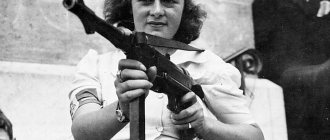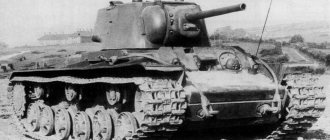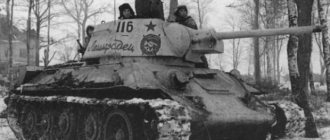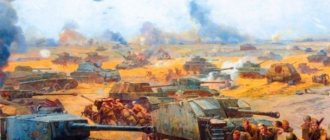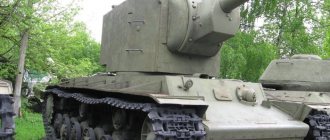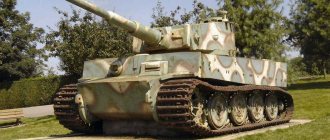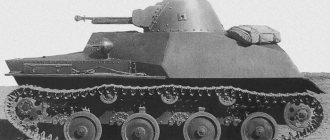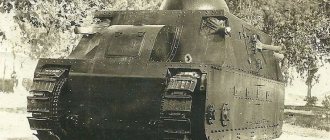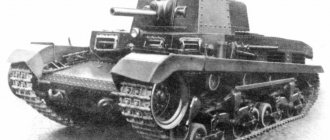Was the T-34 the best tank?
The spirit of a tanker is stronger than steel! The rest is all bullshit! Comrade Stalin taught us that our armor is strong!
Armored tracked vehicles have always occupied a special place in Soviet society. The USSR knew how to make tanks, and they were proud of them. Nimble and nimble “high-speed carts” BT, which chased the samurai at Khalkhin Gol, mobile fortresses KV and IS, “hunters” SU/ISU-152, endless arsenals of post-war T-54/55, one of the best tanks of the twentieth century T-72 “ Ural”... They wrote songs and made films about tanks, they stood on pedestals in every Russian city, and every citizen of the Land of the Soviets knew that “the armor is strong, and our tanks are fast.” Among the many designs created by Soviet tank builders, the T-34 “Victory tank” occupies a special place, whose priority was unconditionally recognized even by foreign experts:
“Exceptionally high fighting qualities. We had nothing like this,” wrote Major General von Melenthin after the first meetings with the T-34. “The best tank in the world,” Field Marshal von Kleist voiced his opinion. “Alarming reports have been received about the quality of Russian tanks. The superiority of the material part of our tank forces, which had existed until now, was lost and passed on to the enemy,” this is how the creator of tank forces, Colonel General Heinz Guderian, spoke about the results of tank battles on the Eastern Front.
An equally high assessment was given to the T-34 by British experts: “The design of the tank demonstrates a clear understanding of the most important combat qualities of armored vehicles and the requirements of war... The creation and mass production of such advanced tanks in such huge quantities represents an engineering and technical achievement of the highest level...”
Constructors' Championship
After comprehensive tests of the T-34 at the Aberdeen Proving Ground, the American military was in no hurry to shower compliments and made quite predictable conclusions, which formed the basis for the enchanting report of the head of the 2nd Directorate of the Main Intelligence Directorate of the Red Army, Major General V. Khlopov:
The T-34 medium tank, after a run of 343 km, was completely out of order, its further repair is impossible... Chemical analysis of the armor showed that the armor plates of the Soviet tank are surface hardened, the bulk of the armor plate is soft steel. The Americans believe that the quality of the armor can be improved by increasing the depth of hardening... An unpleasant discovery for them [the Americans] was the water permeability of the T-34 hull. During heavy rains, a lot of water flows into the tank through the cracks, which leads to failure of electrical equipment...
Tight fighting compartment. The turret rotation mechanism has caused a lot of complaints: the electric motor is weak, overloaded and sparks terribly. The Americans recommend replacing the turret rotation mechanism with a hydraulic system or even a manual drive... The Christie suspension was considered unsuccessful. The spark plug type suspension was tested in the USA back in the 30s, and the American army abandoned it...
The tank, from an American point of view, is recognized as slow-moving (!) - the T-34 overcomes obstacles worse than any of the American tanks. It's all due to a suboptimal transmission. Despite the tank's high thrust-to-weight ratio, the chassis does not allow it to realize its full potential.
The welding of the T-34 hull armor plates is rough and sloppy. The machining of parts, with rare exceptions, is very poor. The Americans were especially outraged by the ugly design of the gearbox - after much torment, they replaced the original design with their own part. It was noted that all the mechanisms of the tank require too many settings and adjustments.
Racing through impassable mud. Sherman and Pershing with more advanced transmissions took the lead.
At the same time, the Yankees meticulously noted all the positive aspects of the T-34 tank, among which there were several unexpected moments:
The choice of angles of inclination of the armor plates of the hull and turret indicates excellent projectile resistance... Wonderful sights. The viewing instruments are unfinished but very satisfactory. Overall visibility is good. I really liked the F-34 gun, it is reliable, has a very simple design, is easy to install and easy to maintain. The aluminum diesel B-2 is very light for its size [of course! The B-2 was developed as an aircraft engine]. There is a desire for compactness. The only problem with the engine was the criminally bad air cleaner - the Americans called the designer a saboteur.
A vehicle from a “special series” was sent to the USA - one of five specially assembled “reference” T-34s, but the Americans were horrified by the low quality of the tank’s parts, the abundance of “childhood diseases” and completely ridiculous, at first glance, design errors. Well, it was a high-volume production product. In difficult times of war, in conditions of evacuation and general chaos, shortage of labor, equipment and materials. The real achievement was not the quality of the armor, but its quantity. Fifty thousand T-34s - approximately the same number of tanks produced by USSR factories by the end of the Great Patriotic War.
Tanks are waiting at the front!
All the advantages and disadvantages of the T-34 were well known in the USSR long before the tests in the USA. That is why the state acceptance department refused to accept the “raw” tank for service for so long, and throughout the war, detailed designs for a new medium tank were developed: T-34M, T-43, T-44, in which the shortcomings of the original “thirty-four” were corrected step by step. The T-34 itself was also continuously modernized during the production process - in 1943, a new three-seat “nut” turret appeared, the four-speed gearbox was replaced with a five-speed one - the tank began to reach speeds of more than 50 km/h on the highway. Alas, the turret moved forward did not allow strengthening the frontal armor; the front rollers were already overloaded. As a result, the T-34-85 continued to run until the end of the war with a 45 mm forehead. The deficiency was corrected only in the post-war T-44: the engine was turned across the hull, the fighting compartment was moved closer to the center, and the thickness of the frontal armor immediately increased to 100 mm.
At the same time, for 1941, the T-34 was a revolutionary vehicle: - a long-barreled 76 mm gun (compared to foreign models of tank weapons) - rational armor angles - a high-torque diesel engine with a power of 500 hp. - wide tracks and excellent cross-country ability. Not a single army in the world had such advanced combat vehicles in service at that time.
Combat classification
Medium tank T-III. 5000 units produced. Medium tank T-IV, the most popular tank of the Wehrmacht. 8600 units produced. Medium tank Pz.Kpfw.38(t) made in Czechoslovakia. 1,400 units entered service with the Wehrmacht. Tank "Panther". 6000 units produced. The Great and Terrible Tiger. 1350 units produced. The number of “Royal Tigers” was in the hundreds: the Germans managed to produce only 492 vehicles. From an arithmetic point of view, the Wehrmacht had about 23,000 “real” tanks (I deliberately did not take into account the T-I wedge, the light T-II tank with bulletproof armor and a 20 mm gun, and the super-heavy Maus tank).
And in war, as in war...
From the point of view of the average person, a steel avalanche of 50,000 of the world's best T-34 tanks was supposed to sweep away all this German rubbish and victoriously end the war on May 9, 1942 (by the way, in 1942 alone, Soviet industry produced 15 thousand T-34s for the front ). Alas, the reality turned out to be discouraging - the war lasted for four long years and claimed millions of lives of Soviet citizens. As for the losses of our armored vehicles, historians cite figures from 70 to 95 thousand tanks and self-propelled guns. It turns out...the T-34 was undeservedly awarded the title of “best tank”? The facts eloquently demonstrate that the T-34 was not the “workhorse” of the Red Army, the T-34 was “cannon fodder”... What is happening, comrades?
Error in calculations
Tanks rarely fight tanks. Despite the colorful descriptions of the duels “T-34 vs Panther” or “Tiger vs IS-2”, half of the losses of armored vehicles were the result of anti-tank artillery. Legendary Soviet “forty-fives”, 37 mm German “mallets”, formidable 88 mm anti-aircraft guns, with the inscription on the carriage “Shoot only at the KV!” - these are the real tank destroyers. It is from this position that one must look at the use of the T-34.
Shots fired at the Soviet 57 mm anti-tank gun ZIS-2. For all occasions.
By the end of the war, the situation for tankers became catastrophic - the Germans managed to create a simple and cheap anti-tank weapon, ideal for combat in urban conditions. The rate of production of “Faustpatrons” reached 1 million per month!
The Faustpatron was not such a formidable weapon for our unsurpassed T-34 tank. During the offensive, I talked very seriously with the personnel and found out that the Faustpatron was a bogeyman that some tanks were afraid of, but I repeat that in the Berlin operation the Faustpatron was not such a terrible weapon as some imagine.”
At the cost of the boastful words of the commander of the 2nd Guards Tank Army, Marshal of the Armored Forces S.I. Bogdanov became thousands of burnt tank crews who did not live to see Victory for only a few days. In our time, the anti-tank rocket launcher continues to remain one of the most terrible opponents of armored vehicles - an extremely secretive, mobile and elusive weapon, which, as practice shows, is capable of destroying any tank, despite the ingenious multi-layered protection.
The second worst enemy of tanks is mines. 25% of armored tracked vehicles were blown up on them. Some of the vehicles were destroyed by fire from the air. When you get acquainted with the statistics, it becomes clear that the tank battle near Prokhorovka is just a rare coincidence of circumstances.
Ferdinand
Discussions about the number of German armored vehicles often bypass self-propelled artillery mounts on German tank chassis. In fact, the Germans managed to create a number of effective anti-tank weapons in this area. For example, the Nashorn (German rhinoceros), little known to the general public, had an 88 mm Nashorn cannon that penetrated any Soviet tank at a distance of 1.5 kilometers. 500 self-propelled guns of this type caused a lot of trouble for the Red Army - there are known cases when a Rhinoceros burned a T-34 company.
Here comes the odious Ferdinand, a miracle of German genius, a heavy tank destroyer weighing 70 tons, crawling out of hiding. A huge armored box with a crew of six people could not turn around on difficult off-road conditions and crawled towards the enemy in a straight line. Despite the mocking attitude towards “Ferdinand”, the issue with its 200 mm forehead was not resolved until the end of the war - “Fedya” did not break through by any conventional means. 90 vehicles turned into a real scarecrow, each destroyed German self-propelled gun was reflected in the reports as “Ferdinand”.
Everyone knows about the 1,400 Czech Pz.Kpfw.38(t) tanks. How many people know about the Hetzer fighter on the chassis of this tank? After all, more than 2000 of them were produced! A light, agile vehicle, with a mass of 15 tons, it had acceptable security, mobility and firepower. The Hetzer was so cool that its production continued after the war, and it remained in service with the Swiss Army until 1972.
Hetzer
Among the numerous designs of German self-propelled guns, the most advanced and balanced was the Jagdpanther. Despite the small number - only 415 vehicles - the Jagdpanthers set the heat on both the Red Army and the allies. As a result, we see that the Germans also required a huge amount of armored vehicles to conduct combat operations; the losses of our tankers no longer seem so incredible. On both sides there were enough tasks for tanks and self-propelled guns: fortifications, equipment, artillery positions, defensive lines, manpower... All this had to be destroyed, crushed, destroyed, overcome, defended, counterattacked and covered.
Medium tanks were an extremely popular type of military equipment - they were distinguished by their moderate weight and rational combination of combat qualities. The German T-IV and T-V Panther tanks, as well as the American M4 Sherman, are most often called analogues of the T-34. Perhaps we’ll start with that.
Universal Soldier
In terms of characteristics, the Sherman is very close to the T-34-85 - heated debates about who was better are still raging. The silhouette of the T-34-85 is 23 centimeters lower. But the Sherman has an upper frontal part of the hull that is 6 mm thicker... Stop! We won’t achieve anything this way; we need to approach things analytically.
Serious studies say that the 76 mm Sherman gun, thanks to the use of BPS, had greater armor penetration, but was inferior to the 85 mm T-34 gun in terms of high-explosive impact. Parity! The T-34 has thicker side armor, and the armor plates have a rational angle of inclination. On the other hand, the slope of the armor plates makes sense when the caliber of the projectile is equal to the thickness of the armor. Therefore, the 75 mm cannon of the Panther penetrated like foil both the inclined 45 mm side of our tank and the 38 mm straight side of the American. I’m not even talking about “faustpatrons”... The combat capabilities of the “Shermans” are most clearly evidenced by the fact that Lend-Lease “foreign cars” entered service only with the Guards divisions. In addition to a comfortable fighting compartment, the Sherman had lesser-known advantages: for example, unlike other medium tanks, it was armed with a heavy machine gun. Tankers liked the accurate and convenient hydraulic drive of the turret - their shot was always the first. And the Sherman was also quieter (the T-34 thundered so much that it could be heard for kilometers).
In addition to 49 thousand tanks, produced in many modifications (each for a specific task), 2 types of multiple launch rocket systems, 6 self-propelled artillery mounts and 7 types of bridge laying vehicles, tractors and repair and recovery vehicles were created on the basis of the Shermans. The T-34 is also not simple: the killer SU-100 tank destroyer, the powerful SU-122 assault gun, three types of tractors, the TM-34 bridge layer and the SPK-5 self-propelled crane were created on the chassis of the Soviet tank. Parity!
As we can see, the differences are minimal, each tank is good in its own way. The only thing that the Sherman lacks is that bright and tragic combat history: the African sandbox, winter fun in the Ardennes and a limited appearance on the Eastern Front cannot compare with the four-year bloody mess that befell the harsh T-34.
Private Panzerwaffe
In the summer of 1941, everything went badly for the German T-IV - Soviet shells pierced its 30-mm sides like a piece of cardboard. At the same time, the “stump” of its short-barreled 75 mm KwK.37 gun could not penetrate a Soviet tank even at point-blank range. The radio station and Carl Zeiss optics are of course good, but what will happen if, for example, the transmission on the T-IV crashes? Oh, this will be the second part of the Marlezon ballet! The gearbox will be pulled out through the shoulder strap of the removed turret. And you say you have problems at work... The T-34 did not have such tricks - the rear part of the tank was disassembled, opening access to the MTO.
It is fair to say that by 1942 technical superiority had returned to the Germans. With the new 75 mm KwK.40 cannon and reinforced armor, the T-IV became a formidable opponent. Alas, T-IV is not at all suitable for the title of best. What is the best tank without a victorious history?! And they collected too few of them: the super-industry of the Third Reich somehow mastered 8686 tanks in 7 years of mass production. Maybe they did the right thing... Suvorov also taught that you need to fight not with numbers, but with skill.
Project disaster
And finally, the legendary “Panther”. Let's face it: the German attempt to create a new medium tank at the height of the war was a complete failure. The “Panther” turned out to be bulky and complex, as a result of which it lost the main quality of a Medium Tank – its mass appeal. 5976 vehicles turned out to be too few for a war on two fronts.
From a technical point of view, the Panther was head and shoulders above the T-34, but it was bought at too high a price - 45 tons of rest weight and eternal operational problems. At the same time, by a strange coincidence, the Panther turned out to be under-armed: the skinny barrel of the 75 mm gun seems to be a clear dissonance against the backdrop of the tank’s massive hull. (They promised to correct the shortcoming on the Panther II by installing a normal 88 mm cannon). Yes, the Panther was strong and dangerous, but its cost and labor intensity of production were close to those of the Tiger tank. At the same time, the capabilities remained at the level of a conventional medium tank.
Results
The best tank, as you already understand, does not exist. There are too many parameters and conditions in this task. The design of the T-34 certainly carried novelty, at the same time, another Designers’ Cup should be awarded to the workers of the Ural factories - they accomplished a feat by starting mass (more correctly, super-mass) production of tanks in the most difficult times for our Motherland. As for combat effectiveness, the T-34 is unlikely to even make it into the top ten. Any “Nashorn” will put the “thirty-four” in the belt in terms of the amount of damage caused per tank. Here the undisputed leader is the invincible “Tiger”.
T-34, Serbia, 1996.
However, there is one more, most important one - strategic offset. According to this competition, each tank should be considered as an element of contributing to the success of the army on a geopolitical scale. And here the T-34 rapidly rises to the top - thanks to its tanks, the Soviet Union defeated fascism, which determined the further history of the whole world.
The path from a simple confectioner to the chief designer of the Kharkov Locomotive Plant
Mikhail Ilyich comes from the Yaroslavl region (the village of Brynchagi). His large family was left without a breadwinner early on. Therefore, fourteen-year-old Mikhail leaves and gets a job as a master’s apprentice at a Moscow confectionery factory. Since 1917, he has been participating in battles as a Red Army soldier. Since 1921, he was a university student at the Faculty of Management, after graduating from which he became the director of a confectionery factory in Vyatka, and later was engaged in party work in the provincial committee of this city.
Since 1929 he has been studying at the Leningrad Polytechnic University. His specialization is transport engineering. After completing the internship, he received an invitation to work at the Putilov plant (later Kirov plant), whose specialists were busy forming the tank industry. M.I. Koshkin is appointed to the position of deputy chief designer.
In 1936, he already headed design bureau No. 183 based at the Kharkov plant. In conditions of mass repression, the position of chief designer was not only responsible, but also dangerous. But Mikhail Ilyich withstands all the tests and difficulties with honor, and his relationship with the team develops well - he managed to find an approach to his subordinates thanks to his personal qualities: efficiency, hard work, honesty and simplicity in dealing with employees.
Crew training
The choice of skills is no less important than equipment, because they can significantly increase the comfort of the game and your effectiveness in battle. The T-34 crew consists of four tankers, the commander has a mixed specialization with the gunner.
Due to the fact that a tank can play several roles on the battlefield and taking into account that the roles of tankers will change in the future, we offer the most balanced and optimal set of perks:
Let's take a closer look at the impact and order of learning skills.
The sixth sense is the most important skill of a commander, it will save your life more than once.
On the brink of war
By the end of the 30s, the coming world conflict was taking on increasingly clear outlines, and European countries were intensively arming themselves. Since the time of the clumsy “steel monsters” of the First World War, a whole generation of armored vehicles and tanks has already been replaced, and the developments of the early thirties are gradually becoming a thing of the past.
Two "thirty-fours" (on the right) in the company of BT-7M and A-20
The country needed an armored fighting vehicle that could confidently operate in a breakthrough and in defense (BT tanks, as it turned out, could no longer provide this). What was needed was a vehicle that was passable and had anti-ballistic armor, reliably withstanding the blow of new and much more powerful anti-tank guns than the German 37-mm “beaters” (which neither the T-26, nor the T-28, nor the T-35 provided). A modern medium tank was required, superior to heavy KVs in mobility, but not inferior to them in firepower and armor protection.
T-34 reservation scheme
Work on the new vehicle began at the Kharkov Design Bureau of Plant No. 183 under the leadership of the legendary “father” of the T-34 tank, Mikhail Ilyich Koshkin, you can read his biography on our portal. Already an experienced designer at that time, who had brought, as we usually say, the lightweight BT-7 to perfection, he enthusiastically headed the work on the new tank. In a short time, Kharkov residents offered two options for the future vehicle with the indexes A-20 and A-32. The “Twenty” turned out to be lighter than necessary and had no potential for modernization, but the military liked the “Thirty-second”.
The creation of a legend and a demonstration performance of the new car in Moscow on March 17, 1940
At the end of winter 1939, the design bureau's work resulted in two experimental tanks with caterpillar tracks. Their combat weight, unlike previous vehicles, has increased by 10 tons, and their armor has become 20-25 mm thicker - and all this without compromising maneuverability and speed. Design bureau employees designed a V-2 diesel engine with a power of 500 horsepower, which made it possible to increase the efficiency of the vehicle and reduce the risk of its fire in the event of a direct hit from an enemy projectile.
